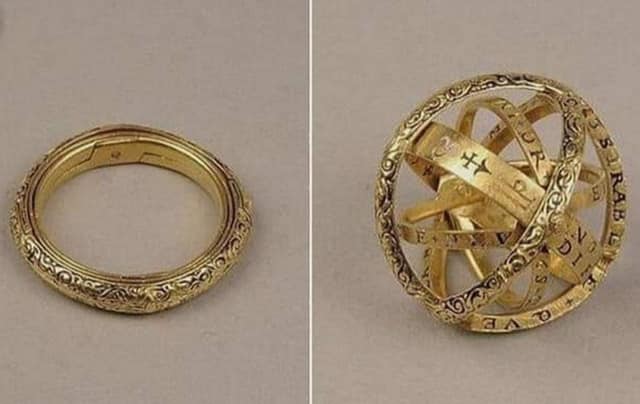
"Rings with a dis­creet dual pur­pose have been in use since before the com­mon era, when Han­ni­bal, fac­ing extra­di­tion, alleged­ly ingest­ed the poi­son he kept secret­ed behind a gem­stone on his fin­ger. (More recent­ly, poi­son rings gave rise to a pop­u­lar Game of Thrones fan the­o­ry...) Vic­to­ri­ans pre­vent­ed their most close­ly kept secrets-illicit love let­ters, per­haps? Last wills and testaments?-from falling into the wrong hands by wear­ing the keys to the box­es con­tain­ing these items con­cealed in signet rings and oth­er state­ment-type pieces."
"Enter the fic­tion­al world of James Bond, and you'll find a num­ber of handy dandy spy rings includ­ing one that dou­bles as a cam­era, and anoth­er capa­ble of shat­ter­ing bul­let­proof glass with a sin­gle twist. Armil­lary sphere rings like the ones in the British Muse­um's col­lec­tion and the Swedish His­tor­i­cal Muse­um (top) serve a more benign pur­pose. Fold­ed togeth­er, the two-part out­er hoop and three inte­ri­or hoops give the illu­sion of a sim­ple gold band. Slipped off the wearer's fin­ger, they can fan out into a phys­i­cal mod­el of celes­tial lon­gi­tude and lat­i­tude."
Rings have served concealed practical functions across history, including poison hidden beneath gemstones and tiny concealed blades. Victorian wearers stored keys to boxes holding illicit letters and wills inside signet and statement rings to prevent unwanted access. Small hidden blades could be lethal and modern analogues might be used to collect an attacker’s DNA. Fictional spy rings perform surveillance and destructive tasks, while armillary sphere rings fold as simple bands yet expand into physical models of celestial longitude and latitude used for study and calculation.
Read at Open Culture
Unable to calculate read time
Collection
[
|
...
]